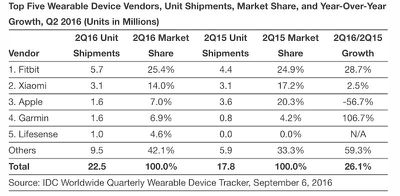New data from market research firm IDC shows a split in the wearables market, with "basic wearables" (Fitbit) gaining popularity, and "smart wearables" (Apple Watch) seeing stalled growth. Despite a portion of the market stalling out, the overall wearable device market grew 26.1 percent in comparison to the year ago quarter, suggesting the burgeoning technology is gaining traction among consumers.
IDC specifically categorizes basic wearables as those devices without third party application support and smart wearables as any device with support for third party applications. Comparing each section's growth from last year, the research firm said that the two categories "traveled at different speeds and directions" in 2016, with basic wearables up 48.8 percent from 2015, and smart wearables down 27.2 percent year-over-year. In total, basic wearables represented 82.8 percent of every wrist-worn device shipped during the quarter.

Basic wearables, which include most fitness trackers, have benefited from a combination of factors: a clear value proposition for end-users, an abundant selection of devices from multiple vendors, and affordable price points," said Ramon Llamas, research manager, Wearables.
"Smart wearables, meanwhile, are still struggling to find their place in the market," added Llamas. "There is plenty of curiosity about what smart wearables – particularly smartwatches – can do, but they have yet to convince users that they are a must-have item. The good news is that smart wearables are still in their initial stages and vendors are slowly making strides to improve them. But this also means that it will be a slow transition from basic wearables to smart wearables."
Apple, representing the smart wearables section of the market, was the only company among the leaders in the wearable market to post a year-over-year decline in shipment volumes, which IDC ascribes mainly to the lack of a second generation Apple Watch on the first generation's anniversary last March. Specifically, Apple again finished third in the overall wearables market with a 7 percent market share and 1.6 million units shipped. In the first quarter of the year, Apple had a 7.5 percent market share and approximately 1.5 million sales for the Apple Watch.

As the Apple Watch stalls, Fitbit has grown, with a 25.4 percent share of the market and 5.7 million units shipped in the second quarter, compared to a 24.5 percent share and 4.8 million units in the first quarter. Because the company's name remains "synonymous with fitness bands," IDC believes its reign will continue in the wearables market. Until smart wearables with various functionalities can justify higher prices to consumers, a more affordable wearable with "a clear value proposition," i.e. fitness-focused features, will help Fitbit remain on top of the market, according to the firm.
Any slowdown in market share of the Apple Watch could also be attributed to prospective buyers holding out for the second generation device, now expected to be announced during Apple's media event set for tomorrow, September 7. In addition to a thinner display and larger battery, the Apple Watch 2 is believed to include GPS, an improved processor, and better waterproofing.























